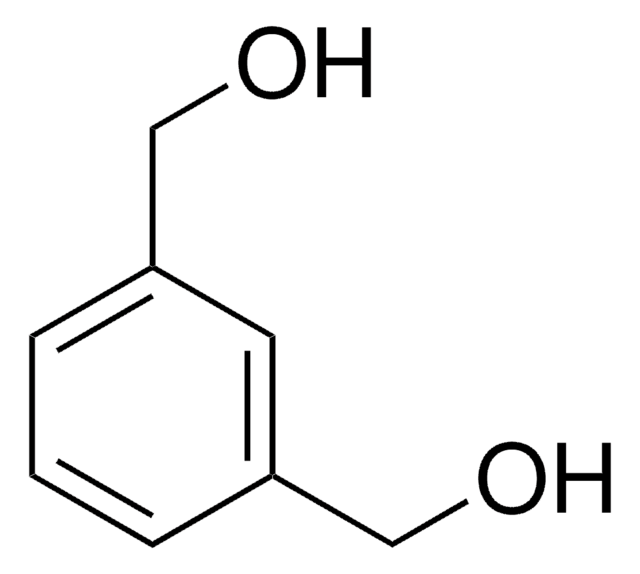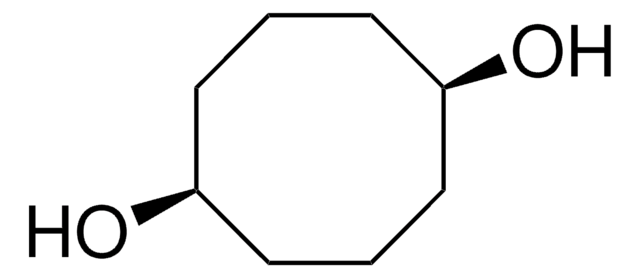125598
1,4-Cyclohexanedimethanol
mixture of cis and trans, 99%
Sinónimos:
1,4-Bis(hydroxymethyl)cyclohexane, mixture of cis and trans
Iniciar sesiónpara Ver la Fijación de precios por contrato y de la organización
About This Item
Fórmula lineal:
C6H10(CH2OH)2
Número de CAS:
Peso molecular:
144.21
Beilstein:
1902271
Número CE:
Número MDL:
Código UNSPSC:
12352100
ID de la sustancia en PubChem:
NACRES:
NA.22
Productos recomendados
densidad de vapor
5 (vs air)
Ensayo
99%
temp. de autoignición
584 °F
bp
283 °C (lit.)
grupo funcional
hydroxyl
cadena SMILES
OCC1CCC(CO)CC1
InChI
1S/C8H16O2/c9-5-7-1-2-8(6-10)4-3-7/h7-10H,1-6H2
Clave InChI
YIMQCDZDWXUDCA-UHFFFAOYSA-N
Categorías relacionadas
Descripción general
1,4-Cyclohexanedimethano is extensively used as cross-linking reagent in polymer industry.
Aplicación
1,4-Cyclohexanedimethanol has been used in the synthesis of polyketal copolymers. It was used as diol comonomer during the synthesis of polyester-carbonates based on 1,3-propylene-co-1,4-cyclohexanedimethylene succinate.
Palabra de señalización
Danger
Frases de peligro
Consejos de prudencia
Clasificaciones de peligro
Eye Dam. 1
Código de clase de almacenamiento
11 - Combustible Solids
Clase de riesgo para el agua (WGK)
WGK 1
Punto de inflamabilidad (°F)
321.8 °F - closed cup
Punto de inflamabilidad (°C)
161 °C - closed cup
Equipo de protección personal
Eyeshields, Gloves, type N95 (US)
Elija entre una de las versiones más recientes:
¿Ya tiene este producto?
Encuentre la documentación para los productos que ha comprado recientemente en la Biblioteca de documentos.
Los clientes también vieron
New biodegradable polymers from renewable sources: Polyester-carbonates based on 1, 3-propylene-co-1, 4-cyclohexanedimethylene succinate.
Liu Y, et al.
Journal of Polymer Science Part A: Polymer Chemistry, 39(14), 2508-2519 (2001)
Stephen C Yang et al.
Bioconjugate chemistry, 19(6), 1164-1169 (2008-05-27)
Acute inflammatory diseases are a major cause of death in the world, and effective treatments are greatly needed. Macrophages play a central role in causing acute inflammatory diseases, and there is currently great interest in developing drug delivery vehicles that
Mingliang Ding et al.
Biodegradation, 23(1), 127-132 (2011-07-07)
Enzymatic hydrolytic degradation of polybutylene succinate (PBS), poly(polybutylenesuccinate-co-1,4-cyclohexane dimethanol) (PBS/CHDM) and poly(polybutylene succinate-co-diglycolic acid) (PBS/DGA) in mixed solvent of tetrahydrofuran (THF) and toluene was examined. Lipase was used as catalyst to degrade polymers with molecular weight of more than 100,000
Pingfan Li et al.
Chemical communications (Cambridge, England), (36)(36), 5412-5414 (2009-09-03)
The silica gel absorbed amino acid salt catalyzed asymmetric intramolecular Robinson annulation reaction has been developed; up to 97% ee was obtained with this readily recoverable organocatalyst.
Zehong Xiang et al.
Macromolecular bioscience, 19(8), e1900112-e1900112 (2019-06-22)
Inflammation-associated thrombosis is a non-negligible source of mortalities and morbidities worldwide. To manipulate inflammation-associated coagulation, nanoparticles that contain anti-inflammatory polymer (copolyoxalate containing vanillyl alcohol, PVAX) and anti-thrombotic heparin derivative deoxycholic acid (Hep-DOCA) are prepared. The strategy takes advantage of the
Nuestro equipo de científicos tiene experiencia en todas las áreas de investigación: Ciencias de la vida, Ciencia de los materiales, Síntesis química, Cromatografía, Analítica y muchas otras.
Póngase en contacto con el Servicio técnico

![4,8-Bis(hydroxymethyl)tricyclo[5.2.1.02,6]decane, mixture of isomers 96%](/deepweb/assets/sigmaaldrich/product/structures/973/006/555dc1f2-c191-4d54-9aea-19fd4c3544a2/640/555dc1f2-c191-4d54-9aea-19fd4c3544a2.png)




![Tricyclo[5.2.1.02,6]decanedimethanol diacrylate](/deepweb/assets/sigmaaldrich/product/structures/327/536/0dc81542-b920-47ec-99c1-d064a327a315/640/0dc81542-b920-47ec-99c1-d064a327a315.png)





